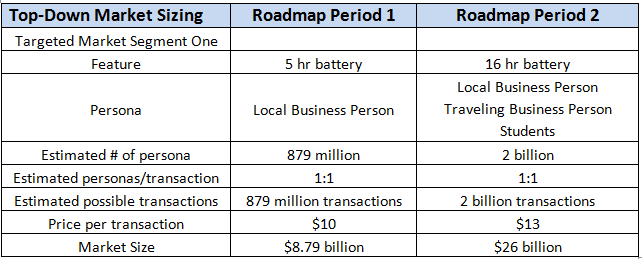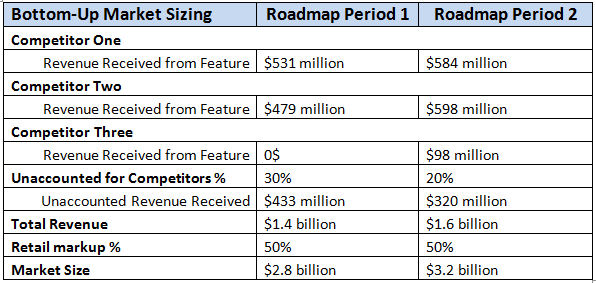Val Workman
The opinions expressed by the bloggers below and those providing comments are theirs alone, and do not necessarily reflect the opinions of Ryma Technology Solutions. As they say, you can't innovate without breaking a few eggs...
Market Sizing
Product management teams all face the challenge of estimating the market size of a feature, product, and/or offering. I've been asked many times for a template that captures the overall objectives of market sizing. I'm showing this template because it illustrates the most common factors, identifies some of the common challenges, and demonstrates the overall concepts used in market sizing.
The first concept to grab is the top-down and bottom-up approaches, which both have their strengths and weaknesses. The concept to grab is that you want both, it's not one or the other. The top-down approach almost always produces a high estimation. The bottom-up approach typically produces the low estimate. Together they provide a maximum and minimum which facilitates computing your estimation risk.

Targeted Market Segment One: This is one of n targeted segments. Each segment is defined by a combination of a product feature and a persona. Take each feature, and identify which if any personas could use that feature. Ask what is the best value proposition that specific feature could make available to that persona. If the value proposition is higher than the cost, we would say that it’s feasible that the market segment exists. If not, keep looking for a persona that would find value in your feature.
Feature: Where I say feature, you can use a product feature, product, service, or packaged offering. In short it's what you’re selling or offering to the market place.
Persona: The use of personas differs a great deal between organizations. For this market sizing template to be any good, your personas need to contain the following information: there needs to be enough information for you to identify what that persona would do with a specific feature, and the persona also must indicate how many of this type of persona there are in the world. Sometimes, persona descriptions also contain information indicating how many of this persona you have access to, and what barriers are keeping you from access to all possible of this persona types.
Estimated # of personas: After identifying a persona, how many individuals are there?
Estimated personas/transaction: Maybe your offering can be shared by individuals within the same company. In this case, you'll need to determine the average number of people per transaction. If your persona is a group, say employees of company Y, you'll also have to make adjustments.

Estimating the revenue received from your competitor may seem difficult. It's much easier with a public company where you can look at their financials. This is one of the reasons folks drop the bottom-up method, but you shouldn't. The effort you put into this estimation can drive the gathering of more competitive intelligence which is out of the scope of this post but still worthwhile.
Of course, over time the objective is to close in on the amount of unaccounted for revenue in your market. Don't kid yourself, there is always a competitor. This activity is a check for your competitive intelligence. If there is a persona in the top-down method, there is a competitor in the bottom-up method. The unidentified competitor is your risk.

Market Size: This is computed by adding the Top-Down and Bottom-Up estimations and dividing by two.
Risk: The market risk is computed by taking the top-down estimate and subtracting the market size from it. The risk percentage is just computed by taking the risk and dividing it by the market size. Don't worry, this is just an example of the template; your estimates will be much better.









But buyers beware, heels are reaching staggering new heights next season. It's very rare for moderators to edit a user profile on Stack Overflow.